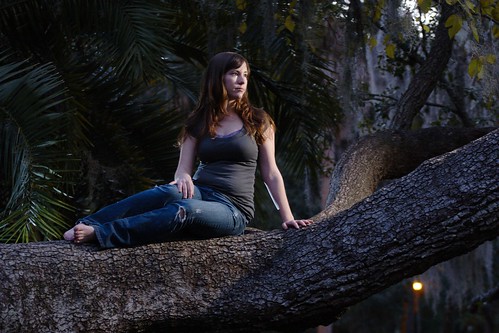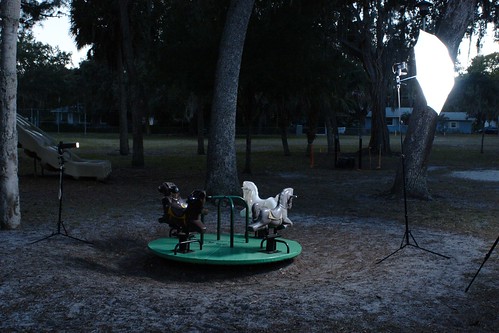Photographic Exercise
December 30, 2010
As far as activities go, photography is pretty benign. Aside from lugging the gear around, there’s generally not much physical exertion to be had on a shoot–not on the part of the photographer, anyways–and it’s certainly far from perilous. My last shoot at Lewis Park, however, turned out to be the exception to the rule. Admittedly, I never truly feared for my life, and none of my muscles ached the next day, but I definitely did a lot more shoving and clinging and climbing than I’ve ever done for a photograph before.
Starting Out
Lewis Park is located near the house where I grew up, and I met my friend Kelsey there to shoot a couple of days ago. We met up right about an hour before sunset, which gave us some time to work in the golden light that you get while the sun is going down. I started out by parking her right in front of a sun-beam streaming through the trees, putting an umbrella up on her opposite side, and doing some simple portraits with just the sun and the one light. I put a 1⁄2 CTO gel on the keylight to better match her face to the golden sunlight, and I kept that gel on that light throughout the shoot.
I always try to start out a shoot with some standard portraits against the nicest backdrop I can find at the location. They’re simple enough that I know I’m guaranteed at least a couple of good solid images right from the beginning, and it’s a good exercise to get me into the swing of manipulating my lights, get a feel for the ambient light, and so on. In this case, I found that the sun was going down a little faster than I expected, and everything under the trees was in really heavy shadow. In the photo above, you can see that the background is barely visible, while the bright sun ray is almost blowing out her hair. For a couple of days I’ve been planning out a shot that involves some motion blur, and I was going to save it until the end when the sun went all the way down, but seeing how dark the shade was I decided to go for it right away.
Round and Round
I recently saw a long-exposure of a spinning merry-go-round, and I thought it would be really fun to shoot something like that…except from a perspective on the merry-go-round. I started out testing the concept by trying to put a tripod on the merry-go-round. It kind of worked, but the shot was insanely tight: this is one of those times when I really wish I had a lens shorter than 28mm. In the end, I decided that I’d just have to hand-hold the shot from on the merry-go-round and do as best I could to get a reasonable field of view. Once I’d verified that I could, in fact, get some decent background blur behind her, I set up some lights. I put an SB-25 in a snoot to the left, and an SB-26 in an umbrella to the right for some fill.
Once I had the lights set up, I got the merry-go-round spinning, jumped on it, and then crouched down and wrapped my arm around one of the horses’ necks, hanging on the outside of the horse. Then I worked my camera up to my eye with my free hand, and focused and triggered the shutter with the same hand that was holding me on to the horse. It was all at once nauseating and frightening. I opened the shutter while Kelsey was around the area where the tree is in that setup shot, and it closed probably 1⁄4 turn after that. The strobes gave me a nice crisp shot of Kelsey while the background blurred into streaks of motion behind her. While a gorrila-pod and a wider lens would have made this shot a whole lot easier, I managed to make it work with just a tiny bit of ingenuity and a less-than-fully-formed self-preservation instinct.
Wrapping Up
After the merry-go-round shot, we decided to go for one final set of portraits on a nearby tree, which culminated in the photo at the top of the page. The tree slopes up and over a little stream at a reasonable angle, so Kelsey was able to get up it without too much trouble. At this point we were well into twilight, so I pushed my ISO up to 800 (I normally keep it at 200) and started looking for a shutter speed that would give me a reasonable amount of background detail. I ended up settling on 1/30s, which was really pushing it even at the wide end of my 70-200, but my strobes froze my subject easily enough, and I managed to hold steady enough to keep the background detail from blurring horribly.
Of course, once she was up in the tree, I had to figure out just how I was going to light her. My light stands were too short; I could have lit her from below, but then she’d have that creepy inverted shadow look on her face, and I didn’t want to do that. Getting a light stand up in the tree was out of the question, but I realized that I could probably get a single strobe to stick up there with a ball-bungee. I put a couple of them in my kit years ago after I read Strobist’s Lighting 101, and since then I’ve never found a situation where it actually helped to ball-bungee a flash to anything. On this shoot, they finally got their day in the sun.
I climbed on up the tree and sure enough, there was a nice skinny branch sticking out of a limb right in front of my subject…it was as if Mother Nature decided to put a light stand there for me. The branch was exactly the right size to hold a flash securely with a ball-bungee, so I attached the light, made sure to set it to its widest zoom setting so I didn’t have to worry about aiming it precisely, and climbed back on down the tree. I used a second light to backlight Kelsey, but I put that one on the ground behind the branch on a fully extended light stand and pointed it up at her. The angle of the backlight isn’t nearly so important as the key light.
If you look closely in the setup shot there, you can see the ball-bungeed strobe on the branch to the right, and the stand directly underneath Kelsey. You may need to view it larger to see where they both are. With the lights in place, I just adjusted their levels until I had a look that I liked, and started shooting. This is the kind of situation where I’m earnestly thankful for the ability to remotely control my power levels with the Radiopopper JrX triggers. Without them, changing the light levels would have meant crossing the stream to get to the backlight and climbing the tree to change the keylight. Remote power control means that I can set my lights up in crazy positions like this and still dial in the power just where I want it.
After finishing those shots, we decided that between the sun going down and the temperature dropping (we’re not accustomed to cold here in Florida), it was time to pack up. So I got my light down from the tree, packed up all the stands, and we parted ways. I ended up with some photographs that I’m really happy with, although unfortunately I lost my last umbrella in the line of duty. A light stand blew over with it, and the fall finally killed it. Fitting, I suppose. While I tempted fate clinging to the outside of spinning metal disks and scaling trees, my trusty umbrella paid the ultimate price.





